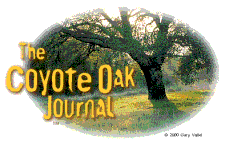Although much of the astronomical and
cosmological knowledge of the Chumash has been lost, there
is little question that the Chumash were expert astronomers.
The arrangement, position and movement of the sun, moon, stars
and planets was inexorably woven into their culture and world
view.
The
following is from Crystals
in the Sky: An Intellectual Odyssey Involving Chumash Astronomy,
Cosmology and Rock Art by Travis Hudson and Ernest Underhay.
"It should
be clear from the chapter summaries that the Chumash shamen-priests
were watching the heavens in earnest and observing the
motions, positions, 'behavior' and characteristics of
a large number of celestial objects. The daily movements
of the sun and moon were unquestionably followed, as were
those of a large number of stars, constellations, and
planets."
According to Crystals in the Sky the Chumash believed
the sun to be a powerful being who lived in the Upper World
in a quartz crystal house with his two daughters. (In my
reading it is not clear whether the
"daughters" represent Venus and Mercury, the two
aspects of Venus, or some other objects or entities.)
The Chumash celebrated solstices and numerous solstice shrines
and observatories have been found. One of these is not far
from where I viewed the June 10 solar eclipse. This animation (used
with the permission of Compass Rose Archaeological, Inc.)
shows the progression of a remarkable "light dagger" on
a target of concentric circles, at sunrise near the Winter
Solstice.
The Chumash that lived near Santa Barbara in the 17th century
might have had a somewhat distorted view of the rarity of
a total eclipse. According to NASA's Fred Espenak, on average
a total eclipse will occur at a particular location on Earth
once every 375 years. In the 56 year period from 1623 to 1679,
the Chumash in this area would have had the opportunity to
observe five total, or near total, eclipses!
Less than two years after the 1677 eclipse, the Chumash
would have had the opportunity to view the total eclipse of April 10, 1679.
This eclipse was of longer duration than the eclipse of 1677
and the sky would have been darker during totality, with Saturn,
Aldebaran, The Pleiades, Venus, Jupiter, and Mercury visible.
It seems plausible that the eclipse-like drawing in Painted
Cave was inspired by these 17th century eclipses. But is it
a literal representation of the eclipse of 1677? Are the companion
objects Mars and Antares? The arrangement of the eclipsed
sun and its red companions is suggestive. But drawings such
as this were usually created by shamen in an altered state.
They are rarely literal and are often difficult to interpret.
Red pigment was common, and used to draw objects of various
colors.
It's fun to gaze in wonder at an eclipse darkened sky and
speculate... What better time, than during an eclipse, would
there be to magically see the daughters of the Chumash Sun?
One of my primary sources of information regarding solar
eclipses was Fred
Espenak's Eclipse Home Page. This web site is NASA's official
eclipse home page. It contains maps and tables for 7,000 years
of eclipses and includes information on eclipse photography,
observing tips and eye safety information. |




